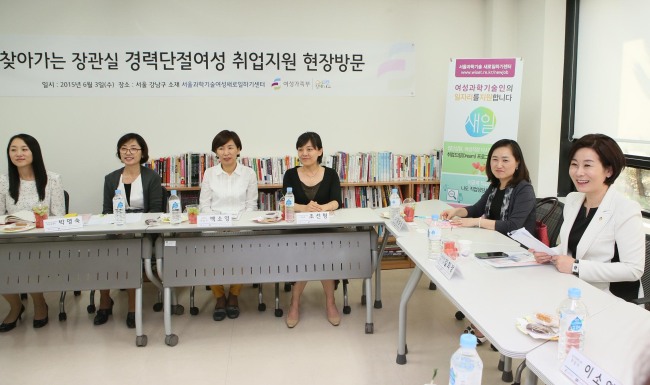South Korea’s Women’s Development Act, implemented in 1995 to protect women’s rights and combat discrimination against women, will be renamed the Gender Equality Act on July 1 to expand the scope of protection against discrimination of both genders, officials said Tuesday.
“We have realized it is important to promote gender equality, the needs of both men and women, rather than focusing on women only,” said Lee Ki-soon, director general of the women’s policy bureau at the Ministry of Gender Equality, on Tuesday.
“We aim to promote that gender equality benefits both men and women, while continuing to protect women who are in vulnerable positions.”
“We have realized it is important to promote gender equality, the needs of both men and women, rather than focusing on women only,” said Lee Ki-soon, director general of the women’s policy bureau at the Ministry of Gender Equality, on Tuesday.
“We aim to promote that gender equality benefits both men and women, while continuing to protect women who are in vulnerable positions.”

Lee explained that the Women’s Development Act has been “the constitution of women’s policies in Korea.” The implementation of the act eventually led to the establishment of other important laws, such as the Domestic Violence Prevention Act and the Act on the Prevention of Sexual Assault, she said.
“I think the act is what also made the abolishment of the male-dominated family registration system possible. That happened only 10 years ago in Korea,” Lee said.
“Changing its name doesn’t mean that we are going to break away from this history. The act will always carry the essence of the initial act.”
One of the biggest changes to follow will be men’s rights to fatherhood in addition to women’s rights to motherhood. Starting July 1, all men will be given the right to take paternity leave once having children. “We believe the new laws will give fathers a greater sense of security,” said Lee.
“Many fathers choose not to take paternity leave fearing that it could lead to career disadvantages. But when the law stipulates that every citizen has the right to family life and parenthood, I think it can make a difference.”
The number of Korean fathers who chose to take paternity leave increased by almost tenfold from 2008 to 2014, from 355 to 3,421. In spite of the increase, however, the number of fathers who took the leave last year only accounted for 4.4 percent of all working dads in the country.
Meanwhile, Korea’s wage gap between men and women last year was 38.9 percent, which was the highest among the OECD countries. In the World Economic Forum’s Global Gender Report in 2013, Korea ranked 111th out of 136 nations.
According to the Ministry of Gender Equality, only 53.9 percent of women were in the labor force in 2013.
The Gender Ministry hopes to increase women’s employment rate to 61.9 percent from last year’s 53.9 by the year 2017. It also hopes to close the gender gap by more than 10 percent by the same year.
Park Nan-sook, the spokeswoman of the ministry, said the name change of the act is to promote work and life balance among all citizens, regardless of their gender.
“It can be a virtuous circle,” she said. “Once more women are in the workforce, more men wouldn’t feel the burden of being the sole breadwinner in the family. When more men participate in child care and domestic affairs, more women would have career opportunities that they would love to fulfill.”
By Claire Lee (dyc@heraldcorp.com)
“I think the act is what also made the abolishment of the male-dominated family registration system possible. That happened only 10 years ago in Korea,” Lee said.
“Changing its name doesn’t mean that we are going to break away from this history. The act will always carry the essence of the initial act.”
One of the biggest changes to follow will be men’s rights to fatherhood in addition to women’s rights to motherhood. Starting July 1, all men will be given the right to take paternity leave once having children. “We believe the new laws will give fathers a greater sense of security,” said Lee.
“Many fathers choose not to take paternity leave fearing that it could lead to career disadvantages. But when the law stipulates that every citizen has the right to family life and parenthood, I think it can make a difference.”
The number of Korean fathers who chose to take paternity leave increased by almost tenfold from 2008 to 2014, from 355 to 3,421. In spite of the increase, however, the number of fathers who took the leave last year only accounted for 4.4 percent of all working dads in the country.
Meanwhile, Korea’s wage gap between men and women last year was 38.9 percent, which was the highest among the OECD countries. In the World Economic Forum’s Global Gender Report in 2013, Korea ranked 111th out of 136 nations.
According to the Ministry of Gender Equality, only 53.9 percent of women were in the labor force in 2013.
The Gender Ministry hopes to increase women’s employment rate to 61.9 percent from last year’s 53.9 by the year 2017. It also hopes to close the gender gap by more than 10 percent by the same year.
Park Nan-sook, the spokeswoman of the ministry, said the name change of the act is to promote work and life balance among all citizens, regardless of their gender.
“It can be a virtuous circle,” she said. “Once more women are in the workforce, more men wouldn’t feel the burden of being the sole breadwinner in the family. When more men participate in child care and domestic affairs, more women would have career opportunities that they would love to fulfill.”
By Claire Lee (dyc@heraldcorp.com)


![[Exclusive] Korean military set to ban iPhones over 'security' concerns](http://res.heraldm.com/phpwas/restmb_idxmake.php?idx=644&simg=/content/image/2024/04/23/20240423050599_0.jpg&u=20240423183955)




![[Herald Interview] 'Amid aging population, Korea to invite more young professionals from overseas'](http://res.heraldm.com/phpwas/restmb_idxmake.php?idx=644&simg=/content/image/2024/04/24/20240424050844_0.jpg&u=20240424200058)

![[Pressure points] Leggings in public: Fashion statement or social faux pas?](http://res.heraldm.com/phpwas/restmb_idxmake.php?idx=644&simg=/content/image/2024/04/23/20240423050669_0.jpg&u=)








